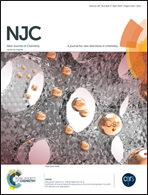Lewis base controlled supramolecular architectures via non-covalent interactions of dioxomolybdenum(vi) complexes with an ONS donor ligand: DFT calculations and biological study†
Abstract
Synthesis and characterization of five new mononuclear dioxomolybdenum(VI) complexes involving the Schiff base ligand (H2L) derived from 2-hydroxyacetophenone and S-benzyldithiocarbazate are reported. The ligand reacted with MoO2(acac)2 and a monodentate Lewis base forming cis-dioxo Mo(VI) complexes of the type [MoO2LB] (where B = THF, 1-methylimidazole, 1-allylimidazole, γ-picoline and pyridine). In all the complexes the ligand is coordinated to molybdenum via tridentate ONS donors phenolic oxygen, imine nitrogen and thioenolate sulfur. The crystal structures of the ligand and the five complexes have been determined by single crystal X-ray crystallography. These complexes are neutral with the metal having distorted octahedral geometry. All the complexes give rise to fascinating supramolecular architectures via hydrogen bonding and π–π stacking interactions. DFT calculations on the ligand and complexes are also carried out. The Schiff base ligand and its dioxomolybdenum(VI) complexes were tested against five human pathogenic bacteria Bacillus cereus, Bacillus subtilis, Proteus vulgaris, Escherichia coli, Pseudomonas aeruginosa and a fungi Candida albicans to assess their efficiency as antimicrobial agents. The MIC (minimum inhibitory concentration) for antimicrobial activity ranges from 1.0–10.0 μg per disc. They were also found to be effective antioxidants of the 2,2-diphenyl-1-picrylhydrazyl (DPPH) radical.


 Please wait while we load your content...
Please wait while we load your content...